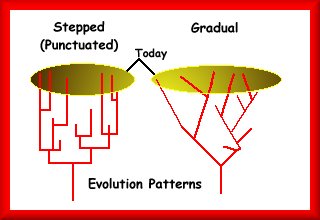
MODULE 9: Evolution in the Fossil Record

Objectives: In this module we will learn about the principles of organic evolution. We also examine how the fossil record provides us with evidence of evolutionary transitions, patterns, and processes.
Background: The idea that organisms of today are modified descendants of organisms past extends back 25 centuries to the Greek, Anaximander (611-547 B.C.). He taught that life arose from the mud warmed in the sun. He suggested an evolutionary sequence where plants came first, then animals and finally humans.
Hence, he came up with the general tenet of evolution (descent with modification) without the benefit of a fossil record! There was little additional development on the idea of organic evolution during the religion-dominated interval before the Renaissance. After the middle ages there are many important people and events in the study of evolution (see history of evolution) A few key individuals are:
Baron Georges Cuvier (1769-1832)
Devises a systematic classification of the animal kingdom by applying comparative anatomy.
Jean Baptiste de Lamarck (writings from 1801-1815)
Reinvigorates the idea that all species are descended from other species.
Suggests that new structures appear because of inner needs ("inner want"). This mechanism of evolution is refuted and later replaced.
Charles Darwin (The Origin of Species By Means Of Natural Selection, 1859)
Provides a comprehensive argument that competition for resources and reproduction, "Survival of the Fittest", explains the variety of life. Organisms that are better adapted to their surroundings when resources are limited will more likely survive and produce offspring.
Darwin's theory of evolution lacks the specific evidence of a mechanism of inheritance.
J Gregor Mendel (1822-1884) a Moravian Monk. Establishes the basis of inheritance by experimenting with different colored garden peas. He calls these "factors", which are today's genes.
For more details on the concepts of evolution... take the "Tour of Evolution".
PATTERNS OF EVOLUTION IN THE FOSSIL RECORD
One of the remarkable features of the fossil record is that it provides us a window to look at biological change over thousands and millions of years. As you have already learned, the types of organisms comprising the fossil record changes dramatically over time. When we look at a sequence of fossils through strata we can often observe transitions in their anatomy. For example, the record of fossil vertebrates demonstrates many transitions between major fossil groups (Examples).
The fossil record indicates evolutionary patterns are complex. Sometimes evolutionary change is rapid followed by intervals of morphological stability (stepped evolution).

In contrast, the fossil record indicates evolution may also be slow and gradual.
We are able to distinguish these evolutionary patterns (tempos) by combining data of anatomical changes through strata with ages determined from absolute dating.
Macroevolution
Another important lesson the fossil record teaches is that the course of life's evolution has been recurrently and dramatically altered by large extinction events. Moreover, that different species and groups of species fare better than others over long geologic intervals (differential species survival). These large scale patterns are termed Macroevolution. We will explore examples of macroevolution (e.g., mass extinction) in future modules.